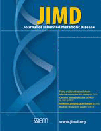Peroxisomal localization of α-oxidation in human liver
Abstract
It was found that α-oxidation in rat liver is a peroxisomal process, consisting of an activation, a 2-hydroxylation, and a reaction leading to the production of formate. α-Oxidation of 3-methyl-substituted fatty acids was quantified by measuring the production of formate and CO2, and the production of a 2-hydroxy-3-methylacyl-CoA-intermediate was demonstrated. We wanted to extend these findings to human liver, in view of the controversy over the subcellular localization of α-oxidation in man.
In homogenates from human liver, rates of α-oxidation were highest when measured in the presence of ATP, CoA, Mg2+, 2-oxoglutarate, ascorbate and Fe2+. In subcellular fractions prepared by differential centrifugation and in fractions obtained after subfractionation of a peroxisome-enriched fraction on a Percoll gradient, production of formate and of a 2-hydroxy-3-methylacyl-CoA intermediate coincided with the peroxisomal marker catalase. In broken fractions, production of CO2 was almost negligible as compared to formate production.
We conclude from our findings that in human liver, as in rat liver, α-oxidation of 3-methyl-substituted fatty acids is a peroxisomal process, consisting of an activation reaction, a 2-hydroxylation reaction and a reaction or reactions leading to the generation of formate as a primary product which is subsequently converted to CO2. Furthermore activation, 2-hydroxylation and generation of formate appear to be coupled (see Casteels et al 1996). These data demonstrate that Refsum disease should indeed be classified as a peroxisomal disease.




